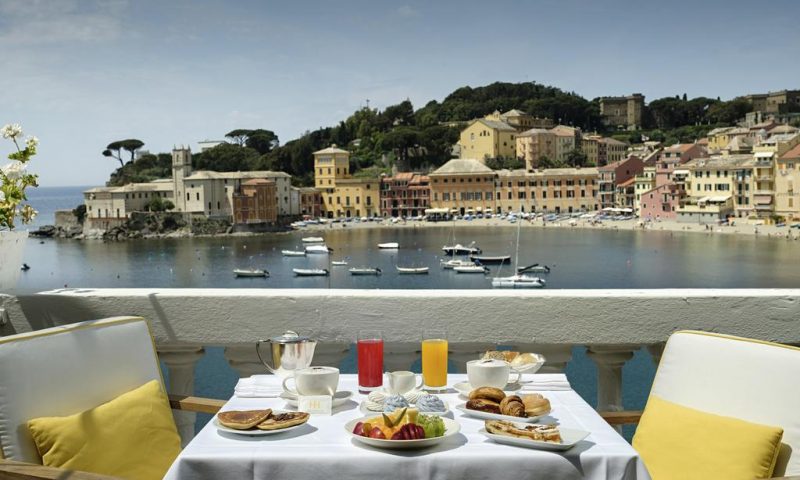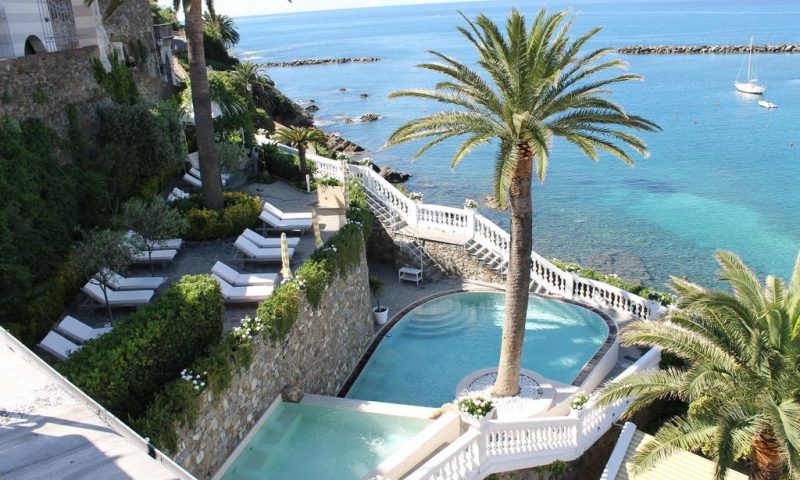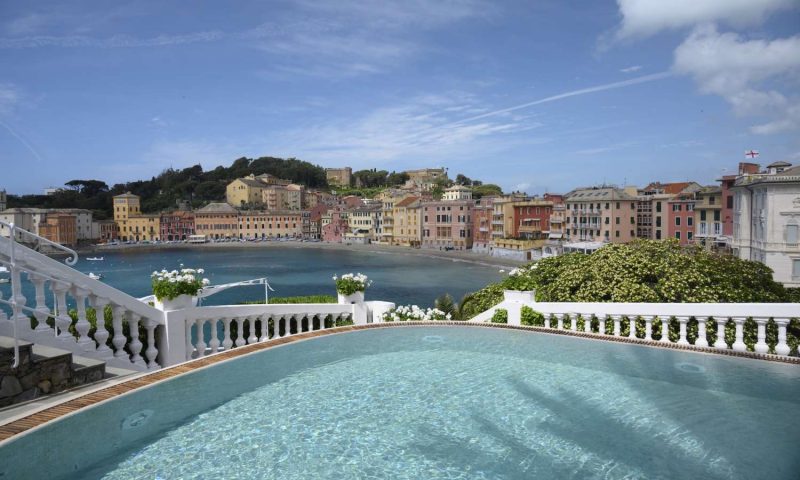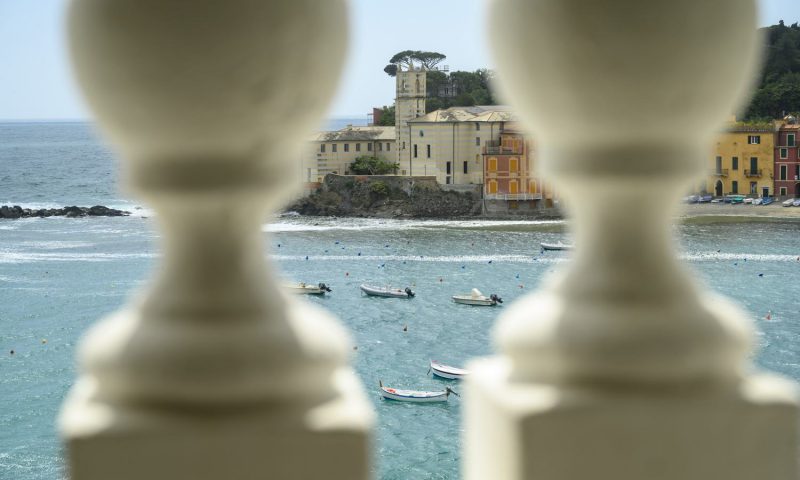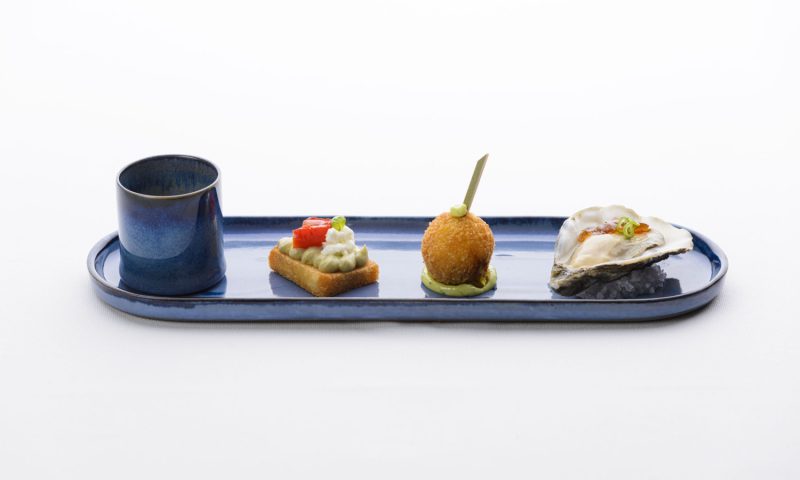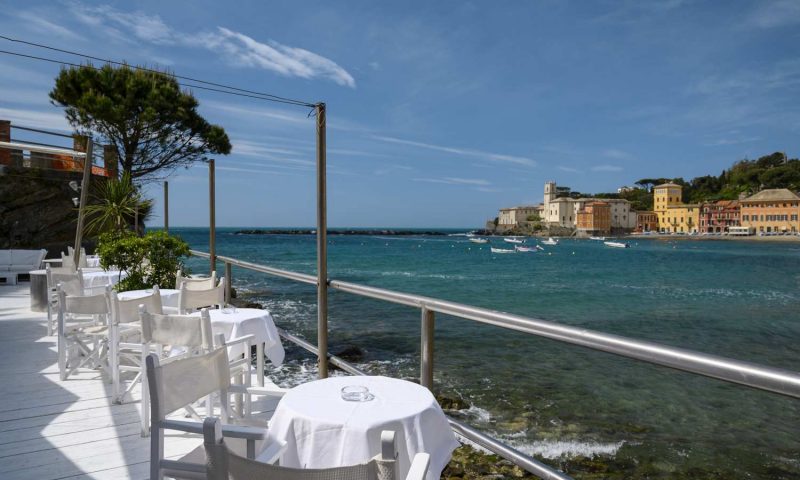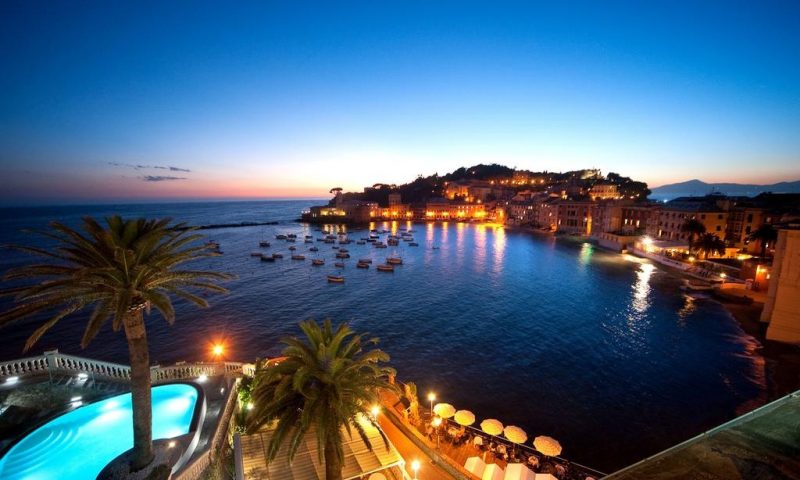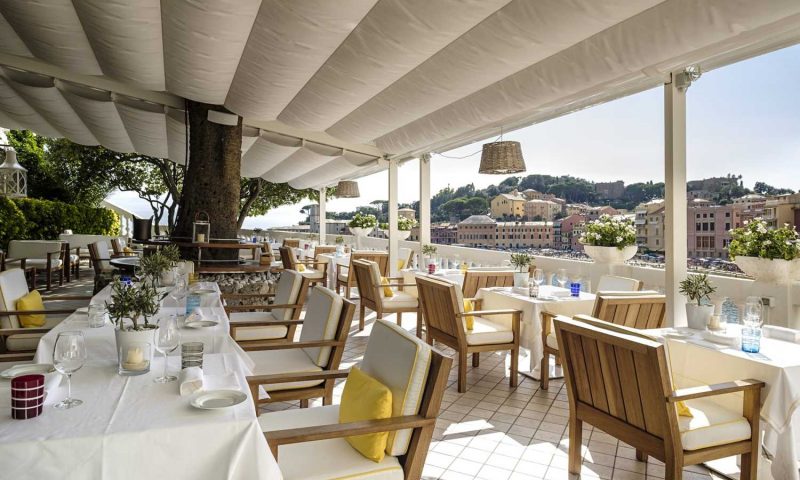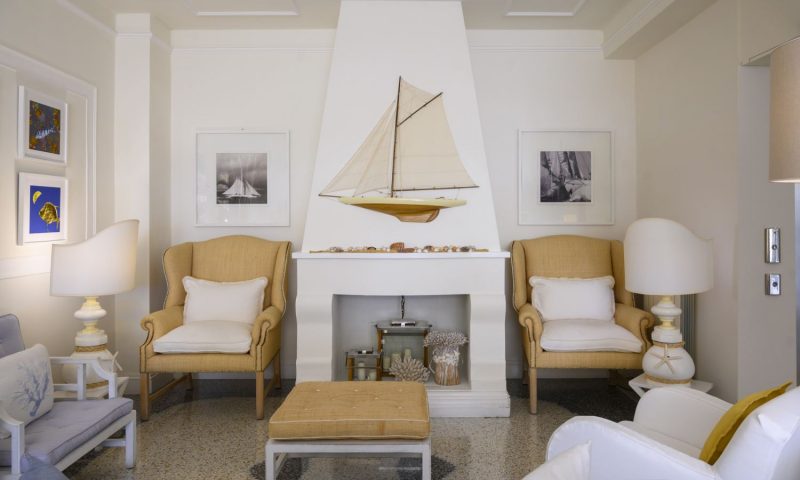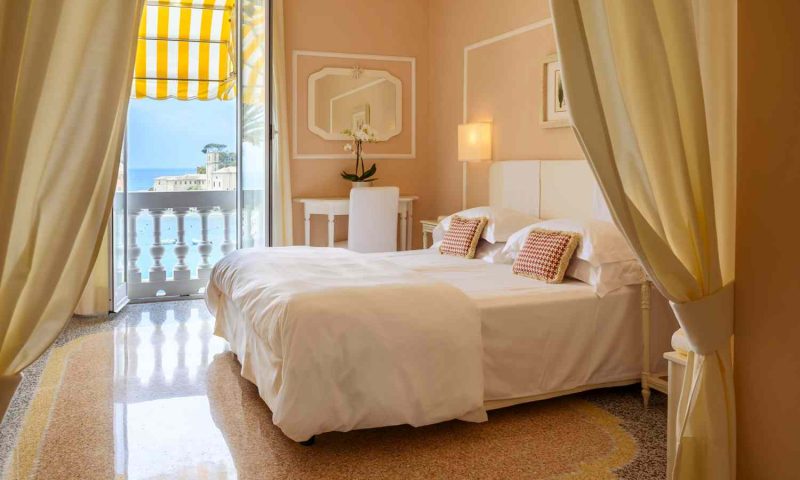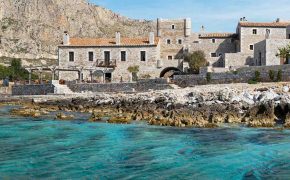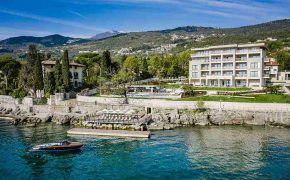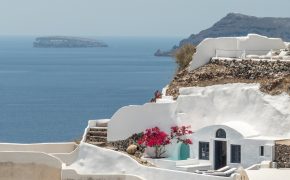Stay at Hotel Helvetia in Sestri Levante is like staying at a friend’s house. A place where you can live exciting experiences, breathe and taste the authentic local culture, have delightful surprises and fall in love with the splendid surroundings.
Located in the gorgeous Baia del Silenzio in Sestri Levante, the Hotel Helvetia will welcome you and offer one of the best holidays you can have.
JUNIOR SUITE
These rooms overlook “Baia del Silenzio” and its gorgeous beach. Our junior suites consist of a double bedroom and an elegant living room equipped with a sofa bed. Every room of this kind has got two bathrooms.
The average size of a room is approximately 35 metres. Two extra beds are only available upon reservation. Nightly turndown service included. All rooms are equipped with air conditioning, safe, LCD TV with satellite dish, telephone, Wi-Fi, hair dryer, minibar, bathrobes, pool towels and slippers.
DOUBLE ROOM WITH SEA VIEW
These rooms offer a breathtaking view as they directly overlook the sea. The average size of the room is 22 metres. You can choose a double bed or two single beds. An extra bed is only available upon reservation; not available for every room in this category. Nightly turndown service included.
All rooms are equipped with air conditioning, safe, LCD TV with satellite dish, telephone, Wi-Fi, hair dryer, minibar, bathrobes, pool towels and slippers.
DOUBLE ROOM WITH GARDEN VIEW
These rooms don’t have a sea view. Some of them overlook the Mandrella hill, while others overlook our garden or our pools. They also include a little terrace that doesn’t overlook the sea.
The average size of the room is 16 metres. You can choose a double bed or two single beds. An extra bed is only available upon reservation; not available for every room in this category. Nightly turndown service included.
All rooms are equipped with air conditioning, safe, LCD TV with satellite dish, telephone, Wi-Fi, hair dryer, minibar, bathrobes, pool towels and slippers.
QUINTOPIANO RESTAURANT
A suspended terrace, an enchanting place that will accompany you until late at night. Our creative cocktails are a must-try. Chef Niimori Nobuya and his grill will add flavour to the sunset at the weekends. During the week don’t miss an interesting variety of dishes to match your drinks.
Chef Roberto Passiatore, with the coordination of chef Niimori Nobuya, presents traditional Italian and Mediterranean dishes you must try. High-quality raw ingredients and originality will delight your palate at lunch and dinner. An accurate selection of sweet and savoury products will enrich your breakfast.
CITTO BEACH BAR
Eyes on the horizon and feet in the sand! Choose Citto for a waterfront lunch or an aperitif with friends. Our beach bar makes your summer moments unforgettable. The charming Citto Beach is located in front of the Hotel, in Baia del Silenzio, where our guests can reserve a beach lounger and enjoy special rates.
THE SWIMMING POOLS
Hotel Helvetia includes panoramic pools with massaging water jets, heated during low season.
CINQUE TERRE
Known and beloved all over the world, the Cinque Terre is the most famous stretch of coast of the entire Liguria. It consists of five little villages nestled between seas and mountains, holding on to steep cliffs and overlooking the crystal-clear waters of the Ligurian Sea.
We are talking about traditional fishing villages encircled by Mediterranean scrub and “heroic” vineyards. Here man has collaborated with nature to create one of the most amazing landscapes in our country.
Once you’ve reached the Cinque Terre, you can travel between the villages by train or, if you love hiking, by walking along the numerous trails of the Cinque Terre National Park. Indeed, there are 120 km of trails inside.
Unfortunately, not all trails are accessible all the time, so it’s recommended that you check in advance at one of the info points in the Park or on Cinque Terre Hiking Guide, website and app downloadable for iOS and Android. Among the most beautiful trails to hike we suggest the following.
SENTIERO AZZURRO
It’s a 12 km-long path that connects Monterosso to Riomaggiore by way of the other three villages.
SENTIERO DELL’AMORE
The stretch of path that connects Riomaggiore to Manarola. It’s currently closed because of a landslide and the reopening is scheduled for 2023.
ALTA VIA DELLE CINQUE TERRE
An alternative to the Sentiero Azzurro that connects Portovenere to Levanto by passing through the entire Park.
VIA DEI SANTUARI
An itinerary on the hillside that connects the main Sanctuaries of the Park.
There are really many things to see when visiting the Cinque Terre. Indeed, besides the natural wonders that you can admire while walking along the paths in the Park, the area preserves a great amount of historical and artistic evidence that is especially interesting.
It’s important to remember that the Cinque Terre area has been inhabited since prehistoric times: for example, there is proof of this in the Grotta dei Colombi on the Palmaria island. Then the Romans came, and testimony can be seen in Portovenere.
Lastly, the first documented stories about the villages of the Cinque Terre as they are known today date back to the 11th century. Lastly there’s Riomaggiore. The houses here climb uphill along the stream.
It’s interesting to know that all of the houses were built with two entrances in order to escape Saracen raids. Among the monuments to visit we suggest the Church of San Giovanni Battista and the Cerricò Castle to admire the landscape.
By walking along a few paths you can reach the Sanctuary of Nostra Signora di Montenero. Whereas if you follow the road along the cliffs you will reach a little beach: if you practice scuba diving, the small port is the meeting point to go and discover the Cinque Terre Protected Marine Area.
WHAT TO EAT & DRINK
Lastly, before leaving the Cinque Terre, it’s essential that you have a taste of the local cuisine. All of the restaurants in the area offer traditional Ligurian dishes, but you definitely have to try the excellent Monterosso salted anchovies and the rice cake. To go with your meal we suggest a nice glass of the white wine Cinque Terre Bianco DOC or of the famous Sciacchetrà.
MONTEROSSO
Monterosso is the first village of the Cinque Terre you will encounter coming from Sestri Levante. The village is split in two by the gallery of the old railway: on one side, the new village with the beach overlooked by the enormous Statue of the Giant and characterized by a large rock in the sea; on the other side, the old village with its colourful houses and narrow alleys.
Montale particularly liked Monterosso and indeed a Literary Park is dedicated to him. During the visit we suggest visiting the Church of San Giovanni, the Castle and the Aurora Tower, the only one that’s left of the 13 towers that stood to defend the village.
VERNAZZA
Vernazza once was the main port for the ships of the Republic and today it’s perhaps the most romantic of the Cinque Terre. The visit can only start from the little port and the Church of Santa Maria di Antiochia, and then continue along the narrow alleys and the steep stairs that will take you to the Doria Castle, from which you can enjoy a gorgeous view.
CORNIGLIA
Corniglia is the only one of the five villages that doesn’t directly overlook the sea. In order to reach the centre you need to “climb” the Lardarina, a staircase made of 33 flights and 377 steps. But once you’ve reached the top, the quiet, little village will be worth the effort.
You have to visit the Parrocchia di San Pietro and the Oratory of Santa Caterina. Whereas if you wish to take a dip, going to the public beach “Spiaggione” is a must: it’s approximately 700 metres long and it’s washed by crystal-clear water.
MANAROLA
The next stop is Manarola, whose houses seem to come directly out of the rock and to hold on to it all the way down to the sea. All around there’s a large area with terraced olive groves and vineyards.
In the upper part of the village you can’t miss the Church of San Lorenzo with its Bell Tower. Manarola is famous for the world’s largest Luminous Nativity Scene which is turned on every year on December 8th.
RIOMAGGIORE
Lastly there’s Riomaggiore. The houses here climb uphill along the stream. It’s interesting to know that all of the houses were built with two entrances in order to escape Saracen raids.
Among the monuments to visit we suggest the Church of San Giovanni Battista and the Cerricò Castle to admire the landscape. By walking along a few paths you can reach the Sanctuary of Nostra Signora di Montenero.
Whereas if you follow the road along the cliffs you will reach a little beach: if you practice scuba diving, the small port is the meeting point to go and discover the Cinque Terre Protected Marine Area.
PORTOFINO
Surrounded by the greenery of the Mediterranean scrub and facing the clear blue waters of the Ligurian Sea, Portofino is one of the most renown destinations of the Region.
Today you can see majestic luxury yachts in its little port and it’s easy to meet VIPs and celebrities at the places in the famous little square. However, the fame of the bay of Portofino can also be seen in the past: indeed, it has always been a safe harbour for ships and boats thanks to its shape.
The history of the village proceeds in stages. Pliny the Elder narrated that in Roman times the name of the location was Portus Delphini. With the domination of the Republic of Genoa, the defence system was implemented. In the 19th century Napoleon’s troops were bravely pushed away from the castle in which they were barricaded.
Lastly, tourism arrived, which made this little gem of Liguria famous all over the world and attracted stars and famous personalities such as Churchill, Grace of Monaco, Clark Gable, Marcello Mastroianni, Liza Minnelli and many more.
Although the village of Portofino is little and its inhabitants are no more than a few hundred, there are many things to do and to see in the area, and it’s advisable to make a note before your arrival so that you can best organize your visit.
Nestled between seas and mountains, the village of Portofino is a little gem: what stands out are the bright colours of the facades surrounding the famous little square that goes down gently towards the small port.
There are many monuments you can’t miss, and among these we suggest the Oratory of Nostra Signora Assunta, the Church of Divo Martino and the Church of San Giorgio, in which the remains of the Patron Saint of Portofino are preserved and from its square you can enjoy one of the most beautiful views of the village.
To admire another gorgeous landscape, we suggest you continue on to Castle Brown (also known as Castle of San Giorgio), an old military fortress that today is a perfect location for exhibitions, meetings and events.
From here you can continue until you reach the Portofino Lighthouse, which has been active since 1910. If you love shopping, in the little village there are some shops with major luxury brands and a few artistic ateliers. Souvenirs are relatively expensive here, but it’s almost impossible to resist the temptation to buy a jar of pesto to bring back to your friends.
THE REGIONAL NATURAL PARK
A peculiarity of Portofino is the fact that it’s located inside one of the most extraordinary natural areas in Liguria: the promontory reaches 600 metres above sea level and it overlooks stunning waters with shades of turquoise and emerald.
The Portofino Regional Natural Park is one of the best places to go for a walk in nature or a slightly harder hike. Indeed, there are about 80 km of trails inside, that twist and turn among nature and ancient historical testimony.
Among the trails that start from the coast of Portofino (“Portofino Mare”), we suggest the path to San Fruttuoso and the evocative Abbey, the easy path to the Lighthouse, the one to the Hermitage of Niasca and the one to the Gassetta Mill, where you can enjoy a pleasant picnic. Inside the Portofino Regional Natural Park there are also numerous mountain bike trails.
THE PROTECTED MARINE AREA
The Portofino Regional Natural Park also includes the Protected Marine Area. On the jagged coastline, the cove of San Fruttuoso and the one of Cala dell’Oro stand out for their beauty.
Then there’s the submerged reefs that are full of life, and a series of unique partial views between the crags that plummet into the sea, with the vegetation that almost touches the water. It’s a gorgeous place just waiting to be discovered: you can do that by kayak or going scuba diving to explore the seafloor. There are many schools that offer courses or day trips.
THE BEACHES
If besides exploring the area you also wish to spend a few hours relaxing, then you should know that in the surroundings of Portofino there are some nice little beaches where you can have a swim and relax in the sun.
The most beautiful and renown of them all is definitely the Bay of Paraggi. Its emerald waters and the seafloor full of life have made it famous all over the world and it’s one of the favourite destinations of VIPs today.
We suggest you go to the beach early in the morning so that you can find a spot for your towel, but especially to enjoy the sun since it starts disappearing in the early afternoon. Besides Paraggi we recommend the little Cannone Bay, perfect for couples, and the Bay of Niasca, a great place for snorkelling.
A trip to Portofino isn’t complete without tasting the local delicacies. Since it’s the province of Genoa, focaccia and pesto are a must, but to try something special you need to look for the Salsetta Portofino: a delicious mix of tomato sauce and pesto. And for a toast? Definitely a glass of Golfo del Tigullio – Portofino or of Portofino DOC.
In order to visit Portofino and its wonders you definitely need an entire day, but in case you have some spare time, among the places to visit in the surroundings we suggest the already mentioned Abbey of San Fruttuoso (you can reach it by taking a boat at the little port), the distinctive village of Camogli and the larger towns of Santa Margherita Ligure and Rapallo.
SAN FRUTTUOSO
Nestled between seas and mountains, San Fruttuoso di Camogli is a little gem of Liguria: it’s a very tiny bay reflected in the crystal-clear sea. Here man has managed to build – almost as if by magic – a few modest fishermen houses, a tower and an elegant church. Hidden and almost inaccessible, this inlet has preserved its beauty unaltered for centuries and the visitor who dares
This is one of the most evocative itineraries in the Park. Start from the little port of Portofino, under the Carabinieri barracks, and go up a mule track signalled with two red circles.
Go past San Sebastiano and Cappelletta, and proceed to Base 0. The slope to San Fruttuoso starts here. The trail signs to follow are still the two red circles. It’s about two hours long and the path is easy even though the first part is uphill.
At the exit of the Camogli train station, take the stairs on the left until you reach the Church of Boschetto, then proceed along some other stairs and “creuze” (typical Ligurian narrow lanes) to Ruta.
Here take the path to Portofino Vetta on the left of the Church, it’s signalled with a red square. From there you will reach the passage Pietre Strette, then go down to San Fruttuoso. The itinerary is about 2 and a half hours long.
At the exit of the Camogli train station, go down to the car park in front of the Carabinieri barracks and take the path/stairs to San Rocco. From the Church of San Rocco, go down the path to Punta Chiappa until you reach the Complesso di San Nicolò di Capodimonte.
From here take the path to San Fruttuoso. The itinerary is about 3 hours long. If you wish to reach Portofino coming from Sestri Levante, you need to take the train to Santa Margherita Ligure and then bus n° 82 to get to the village. Whereas to reach Camogli, you just need to take the train and get off at the station of the same name.
Once you have reached San Fruttuoso, the things to see are not so many, but they can definitely amaze and, once again, demonstrate how man and nature, in Liguria, have always known how to coexist.
The origins of the Abbey date back to the 8th century, when a group of monks found a suitable place for building a church in this bay, near a source of fresh water.
Legend has it that the building of the Abbey of San Fruttuoso di Camogli was commissioned by San Fruttuoso himself, that – in a dream – suggested the bay to Prospero, bishop of Tarragona, who fled Spain and brought the ashes of the Saint to safety.
However, it is thought that the current Abbey dates back to the 10th or 11th century: it seems that the church was rebuilt by order of Adelaide of Burgundy, the widow of Otto I.
Expansion and restoration works were numerous over the centuries, especially thanks to the Doria family who, in 1983, donated the complex to the FAI (Fondo Ambiente Italiano, the National Trust of Italy) which manages it to this day.
Besides the Church, the Abbey also includes a Museum that traces its history and an elegant cloister that contains the tombs of the Doria family.
On the outside, the Doria Tower stands to protect the bay and its water source. It was erected in 1562 on the narrow street that connects the Abbey to the little fishing village, and it was equipped with light and heavy artillery. Today you can go up to the top to enjoy a spectacular view over the sea.
Right in front of the Abbey of San Fruttuoso there’s a little strip of white pebbles where you can allow yourself a few hours of relaxation after visiting the complex.
The beach consists of an equipped area and a public area. In the summer they are both really crowded, so it’s advisable to reach San Fruttuoso early in the morning or late in the afternoon.
You can spend an entire day in San Fruttuoso di Camogli and, besides eating a simple sandwich on the beach, it could be a good idea to have lunch in one of the restaurants of the village.
All of the places usually offer typical Ligurian cuisine and fresh fish to match with a nice glass of the local wine. Don’t miss the pesto lasagnette (“mandilli de sea”), the prawns of Santa Margherita and a glass of Golfo del Tigullio – Portofino DOC.
